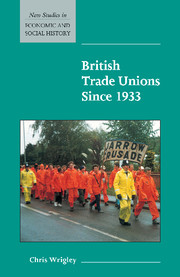Book contents
- Frontmatter
- Contents
- List of tables
- 1 Introduction
- 2 Economic recovery and war, 1933–1945
- 3 Trade union development, 1945–2000
- 4 Strikes, 1945–2000
- 5 Incomes policies, 1948–1979
- 6 Trade union legislation, 1945–2000
- 7 What have trade unions done?
- List of references
- Index
- Studies in Economic and Social History
- New Studies in Economic and Social History
2 - Economic recovery and war, 1933–1945
Published online by Cambridge University Press: 05 June 2012
- Frontmatter
- Contents
- List of tables
- 1 Introduction
- 2 Economic recovery and war, 1933–1945
- 3 Trade union development, 1945–2000
- 4 Strikes, 1945–2000
- 5 Incomes policies, 1948–1979
- 6 Trade union legislation, 1945–2000
- 7 What have trade unions done?
- List of references
- Index
- Studies in Economic and Social History
- New Studies in Economic and Social History
Summary
British trade unions emerged from the Second World War with both their size and their political and social status enhanced. There is not much controversy about that. But there is less recognition of the scale of the recovery of trade union membership, 1933–9, and there is controversy as to the extent to which governments consulted trade unions and its significance.
The world recession of 1931–3 hit British trade unionism less hard than that of 1921–2. In 1920 British trade unionism was stronger than it was to be again until 1974 in terms of trade union density (the percentage of trade union members in the workforce legally eligible to join a union) or, in crude membership numbers, until 1946. In the earlier period trade union membership tumbled from 8,253,000, a 48.2 per cent density in 1920 to 5,382,000, a 30.7 per cent density, in 1923. In contrast, the drop in trade union membership was much less in the early 1930s, from 4,783,000, 25.7 per cent density in 1930 to 4,350,000, 22.9 per cent density in 1933. In other words, the 1917–20 boom in trade unionism was substantially undercut in 1921–2 and subsequent years, while trade union membership had a lesser height from which to fall in 1930–3. That said, trade union density at its inter-war nadir at 22.9 per cent was only lower than that of 1913–14 of the years before the First World War (and much higher than the 16.2 per cent average of 1904–13).
- Type
- Chapter
- Information
- British Trade Unions since 1933 , pp. 7 - 17Publisher: Cambridge University PressPrint publication year: 2002



